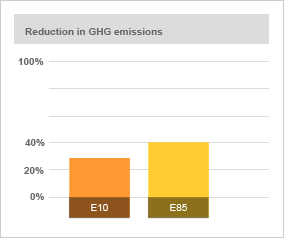Currently, transportation is the largest single source of air pollution in the United States producing nearly two-thirds of the carbon monoxide, a third of the nitrogen oxides, and a quarter of the hydrocarbons in our atmosphere.10 Adding ethanol to gasoline changes that formula dramatically. Ethanol burns more cleanly than gasoline,11 so the more ethanol you add to your fuel mixture, the less pollution your car produces. Cars using E10 emit 20 percent less carbon monoxide than those burning conventional gasoline, while cars running E85 emit a full 40 percent less.12 Consumer Reports magazine recently took a flex-fuel Chevrolet Tahoe to a Connecticut emissions test facility and had it tested using both E85 and conventional gasoline. “We found a significant decrease in smog-forming oxides of nitrogen when using E85,” the magazine reported.13
 The impact of E85 on greenhouse gas emissions is equally impressive. Fueling a car with E85 reduces greenhouse gas emissions by 20 percent, according to studies by Argonne National Laboratory.14 But this is only the beginning of ethanol’s potential. The benefits will increase as larger amounts of ethanol are produced from cellulosic sources, such as agricultural waste that is currently burned or left to decompose. When E85 is used, cellulosic ethanol can reduce greenhouse gas emissions per vehicle mile traveled by 89 percent.15
The impact of E85 on greenhouse gas emissions is equally impressive. Fueling a car with E85 reduces greenhouse gas emissions by 20 percent, according to studies by Argonne National Laboratory.14 But this is only the beginning of ethanol’s potential. The benefits will increase as larger amounts of ethanol are produced from cellulosic sources, such as agricultural waste that is currently burned or left to decompose. When E85 is used, cellulosic ethanol can reduce greenhouse gas emissions per vehicle mile traveled by 89 percent.15
The Natural Resources Defense Council projects that “by 2050, biofuels – especially those known as cellulosic biofuels – could reduce our greenhouse gas emissions by 1.7 billion tons per year. That's equal to more than 80 percent of current transportation-related emissions.”16
And because ethanol does not need to be drilled or pumped, it leaves America’s coasts and wildlands unscathed. It is produced from fully renewable and fully sustainable resources – a fuel we can find at home and recover from our own fields, forests, and farmlands, or even from our own garbage dumps.
All of these things – and the fact that E85 costs roughly the same as gasoline – have made it popular with consumers. A June 2006 poll by Maritz Automotive Research Group found that four out of five Americans would consider buying a car that can run on E85. The reasons cited: lowering fuel costs, protecting the environment, and reducing dependence on foreign oil.17


